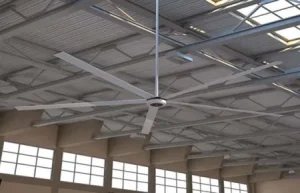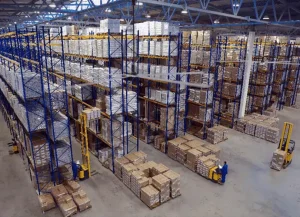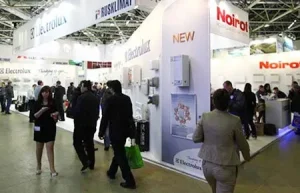Sweltering conditions and high energy costs undermine comfort in large spaces like warehouses, gyms, and industrial sites. Conventional fans struggle to circulate air evenly, leaving stuffy corners or overcooled spots. A way out? HVLS fans revolutionize air circulation with low speed technology, unifying room climates while lowering utility bills.
HVLS fans, or High-Volume, Low-Speed fans, are large ceiling fan solutions built to move air gently across wide footprints, typically in industrial or commercial spaces. Unlike smaller high-speed fans, HVLS fans feature broad diameters—up to 24 feet—and rotate slowly, pushing massive airflow throughout the area. By reducing hot spots and supporting air conditioning systems, they slash energy usage and improve occupant comfort. Whether in a warehouse, sports facility, or school gym, HVLS offers energy efficiency and thorough climate control at minimal maintenance costs.

HVLS Fan in action
HVLS fans—“High-Volume, Low-Speed”—are fans designed specifically for large spaces. Ranging up to 24 feet in diameter, these overhead giants circulate enormous volumes of air at a low speed, ensuring uniform comfort without disruptive gusts. The question arises: Are HVLS fans worth the effort and initial cost?
In industrial spaces—factories, distribution centers, etc.—air stagnation can hamper worker productivity. HVLS fans mitigate temperature extremes by gently redistributing air from ceiling to floor. This stable environment helps employees feel better, fosters safer conditions, and lowers reliance on hvac or air conditioning units.
Key Differences:
Expert Take: Many facility managers note that one large HVLS can eliminate the need for multiple smaller fans, reducing overhead and maintenance.
Fans are built to push large amounts of air effectively. A low-speed fan in the HVLS category may spin at around 50–120 RPM, but due to the large fan diameter, it displaces a large volume of air each rotation. This approach fosters uniform air circulation at minimal power consumption, making HVLS especially appealing in areas with high energy costs or climate extremes.
Fans operate quietly, mitigating noise distractions, which proves beneficial for schools, sports centers, or open-concept offices. By steadily circulating air, these fans also reduce humidity and improve air quality, benefitting occupant health.
In contrast, a “high-speed” or “regular ceiling fan” might revolve quickly, stirring up localized gusts but failing to unify a bigger floor area. If you rely on multiple smaller devices, the energy usage can be steep, and occupant experience might still be uneven. HVLS counters that by handling a broad footprint with one or few fans, so coverage remains consistent, and your maintenance costs often drop.
At first glance, you might assume a bigger fan demands more electricity. But HVLS solutions rely on slow rotation, meaning minimal friction and moderate motor load. They displace thousands of cubic feet of air per minute without spinning intensely. Because of the low speed, fans are designed to move the same or more volume of air compared to multiple small fans, but using less energy per square foot covered.
| Fan Type | Speed | Coverage | Energy Efficiency |
|---|---|---|---|
| Small, high-speed fan | 1000+ RPM | ~200 sq. ft. | Less efficient if many are needed |
| HVLS fan | 40–120 RPM | 10,000+ sq. ft. | Typically more efficient overall |
HVLS fans help your building’s heating and cooling demands. In summer, they provide a gentle breeze that reduces the perceived temperature, trimming AC reliance. In winter, they push warm air down from the ceiling, cutting heating usage. This synergy lowers total building energy consumption while boosting occupant comfort year-round.
Data: Some large facilities can cut overhead on climate control by 20–30% by pairing HVLS with existing HVAC, thanks to consistent air mixing.
Big spaces—like a warehouse, manufacturing floor, or sports arena—cry out for thorough air circulation. Standard ceiling fans might handle a living room or office, but they fail in multi-thousand-square-foot footprints. Meanwhile, HVLS was born for such tasks, built with extensive diameters to unify room climate across wide areas.
HVLS fans revolve at low speed, creating a broad vortex of airflow across large square footage. This single fan can replace multiple smaller ones, diminishing mechanical or noise clutter. By reducing the number of fans needed, you also diminish potential mechanical breakdowns or complex wiring. Fewer fans running at partial speeds typically consume less energy overall than many small fans operating at full blast.
Fans provide occupant comfort in warehouse aisles, school gym bleachers, or commercial assembly lines. Because HVLS solutions revolve so gently, employees or visitors don’t suffer from harsh blasts of air. Instead, they benefit from a stable environment that fosters morale and productivity.
All fans revolve to push air. But HVLS fans rely on large, aerodynamically contoured blade shapes that catch extensive columns of air with each rotation. By pushing the air downward, the fan “spreads” the breeze outward along the floor. This approach can handle thousands of square feet, creating uniform conditions that prevent hot pockets from forming.
Fans can also help in vertical mixing—pulling hot air from the ceiling down to occupant level. This effect is critical during colder months, distributing heated air more effectively, thus possibly lowering your heating load.
High-speed devices often create localized wind tunnels or swirl dust. Conversely, a HVLS’s gentle motion can keep dust or airborne particles down, preserving better air quality. The occupant experiences a gentle breeze rather than blasts of wind. It’s particularly beneficial in gyms or sports centers where overhead fans produce a calming environment, not major drafts.
Case: A manufacturing plant replaced multiple box fans with two HVLS overhead solutions, seeing more stable temperatures, lower dust accumulation, and fewer employee complaints about dryness or wind chill.
Comparing “big ceiling fans” (like HVLS) with small, high-speed models reveals distinct contrasts in performance, coverage, and usage contexts.
| Attribute | HVLS Fan | High-Speed Fan |
|---|---|---|
| Speed | low speed (30–120 RPM) | 200–400+ RPM, quick spin |
| Coverage | Thousands of sq. ft. per fan | Localized area, best for smaller zones |
| Energy Efficiency | Generally very efficient for large footprints | May be less efficient if many fans are used |
| Noise | Quiet, minimal disruption | Can be noisy at high speeds |
| Application | Industrial floors, warehouse, large gyms | Residential spaces, small shops, personal cooling |
If your building is roughly 10,000 sq. ft. or more, an HVLS approach generally outruns standard fans. For modest areas, or those requiring short bursts of intense breezes, smaller fans might suffice. The question: do you want broad climate unification or local spot-cooling?

HVLS Fans in large Warehouse
hvls fans worth the investment frequently arises among facility managers. Yes, HVLS solutions can cost more upfront than typical fans. But consider:
HVLS fans also last for years with minimal maintenance demands. Because they revolve slowly, wear and tear remains minimal. Many big brands—macroair fans, big ass fans®, or other producers—offer robust warranties. Over time, the energy savings, occupant satisfaction, and fewer mechanical breakdowns typically offset the higher initial cost.
Conclusion: While cheaper solutions might exist, HVLS remains the gold standard for truly large footprints. If occupant comfort, energy efficiency, and stable operation matter, the ROI often turns positive within 2–3 years.
8. MacroAir Fans, Big Ass Fans®, and Other HVLS Brand Solutions
When discussing HVLS, certain names stand out: MacroAir Fans, Big Ass Fans®, plus other specialized providers. All revolve around the same principle—high-volume air distribution at low speed, a strategy that allows HVLS fans to optimize both comfortable environments and operational costs through efficient airflow management.
MacroAir Fans
MacroAir helped pioneer HVLS technology, known for fans used in commercial, industrial, and even agricultural settings. Their designs emphasize advanced blade engineering, robust motors, and easy control. Many facility owners find the synergy of wide coverage plus minimal mechanical fuss compelling.
Big Ass Fans®
This brand stands out for massive overhead solutions in warehouses or sports facilities. Reputed for delivering strong, reliable performance, Big Ass Fans® excel in pushing large volumes of air in big footprints. They often incorporate advanced controlling technology for speed, airflow, and scheduling.
Innovation in Niche Markets
Specialized manufacturers like Vindus Fans further refine HVLS efficiency through Direct Drive motors, eliminating gear-related energy losses. Their designs meet ANSI/ASHRAE 216P airflow standards while achieving sub-45 dB noise levels—critical for noise-sensitive environments. Compliance with EN/CE/IEC safety certifications ensures durability in demanding settings, and modular controls enable seamless integration with building automation systems. These advancements highlight how emerging brands expand HVLS applications without compromising its core low-speed, high-efficiency principles.
Ultimately, the core value of HVLS systems lies in their ability to provide large-scale air movement with minimal energy consumption. Whether through advanced controls, robust motors, or innovative blade designs, these fans offer a sustainable way to address thermal comfort and energy efficiency in diverse spaces.
To find the “right fan,” measure your building’s large space carefully. HVLS solutions typically demand a minimum overhead clearance—somewhere around 15+ ft. total, so there’s safe distance between the fan blade tips and occupant traffic.
Each building has unique occupant density, HVAC usage, or process heat output. If you operate in a high-heat environment, your HVLS might need robust torque and advanced control for variable speeds. If occupant density is uneven, you might place multiple smaller HVLS fans.
Fans are typically installed near the center or symmetrically spaced to unify the environment. Selecting the right diameter is key to ensuring the fan can effectively handle the entire footprint. Too small, you’ll find corner hot spots. Too large, you might face issues with overhead obstacles or overkill capacity.
If energy usage is a prime concern—like it is for many climate-conscious facilities—HVLS solutions can be a major asset. By gently mixing air, they let your air conditioning systems or heating run less often or at higher setpoints, saving on monthly bills. Over time, the net savings often surpass the fan’s upfront cost.

Choosing the Right HVLS Fan
Are HVLS fans only for industrial or warehouse settings?
While they’re perfect for large warehouse floors or industrial sites, HVLS solutions also appear in gyms, schools, big restaurants, or even spacious commercial lobbies. Anywhere you want broad, low speed air coverage, HVLS thrives.
Do HVLS fans operate effectively in winter?
Yes. They can push heated air from the ceiling down to occupant level, diminishing heating loads. The year-round utility is a big advantage of hvls fans—fans can also help unify climates in cold months.
How do HVLS fans handle humidity or odor control?
By circulating large amounts of air and preventing stagnant zones, HVLS can reduce moisture buildup or odors, improving occupant health and product preservation. This advantage is especially vital in food processing or packaging facilities.
Is the initial cost high for HVLS solutions?
Though the initial cost can exceed that of smaller fans, the long-term energy savings, occupant comfort, and fewer fans needed often make HVLS a wise investment, paying off in reduced overhead or improved productivity.
What diameter is typical for an HVLS?
Diameters typically range from 8–24 ft. The best fit depends on your ceiling height, occupant load, and layout. Larger diameters effectively unify climates in bigger footprints.
So, are HVLS fans worth it? For large environments—factories, sports centers, gyms, schools, warehouses, or manufacturing facilities—the answer is often “yes!” By harnessing low speed rotations, broad fan blade diameters, and advanced airflow design, HVLS solutions transform occupant comfort. They unify temperatures from floor to ceiling, reduce AC or heating load, and promote healthier air quality.
At our hvls fans Manufacturing facility, we relish guiding customers to the best fan approach for their building. HVLS fans spark synergy with your existing hvac systems, saving on monthly bills and delivering occupant comfort. If you have a giant warehouse, sports arena, or expansive production plant, a single HVLS might supplant an entire army of smaller fans—ensuring stable, breezy conditions and minimal overhead.
Remember: A HVLS fan merges high-volume coverage with low-speed rotation, providing the ability to unify indoor environments cost-effectively, quietly, and efficiently. Whether you choose MacroAir Fans, Big Ass Fans®, or specialized solutions like Vindus Fans, these systems offer a path to a stable, energy-efficient climate year-round. By prioritizing adaptive airflow designs and energy-saving motors, brands such as Vindus Fans further demonstrate how HVLS technology can optimize operational costs while maintaining consistent comfort—proving that large-scale air management need not compromise affordability or quality.
If you’re considering adopting HVLS in your facility, contact our team at hvls fans Manufacturing to discover how these big low-speed solutions can unify your environment, reduce costs, and keep occupant satisfaction soaring!

Hi, I’m Michael Danielsson, CEO of Vindus Fans, with over 15 years of experience in the engineering and design industry. I’m here to share what I’ve learned. If you have any questions, feel free to contact me at any time. Let’s grow together!